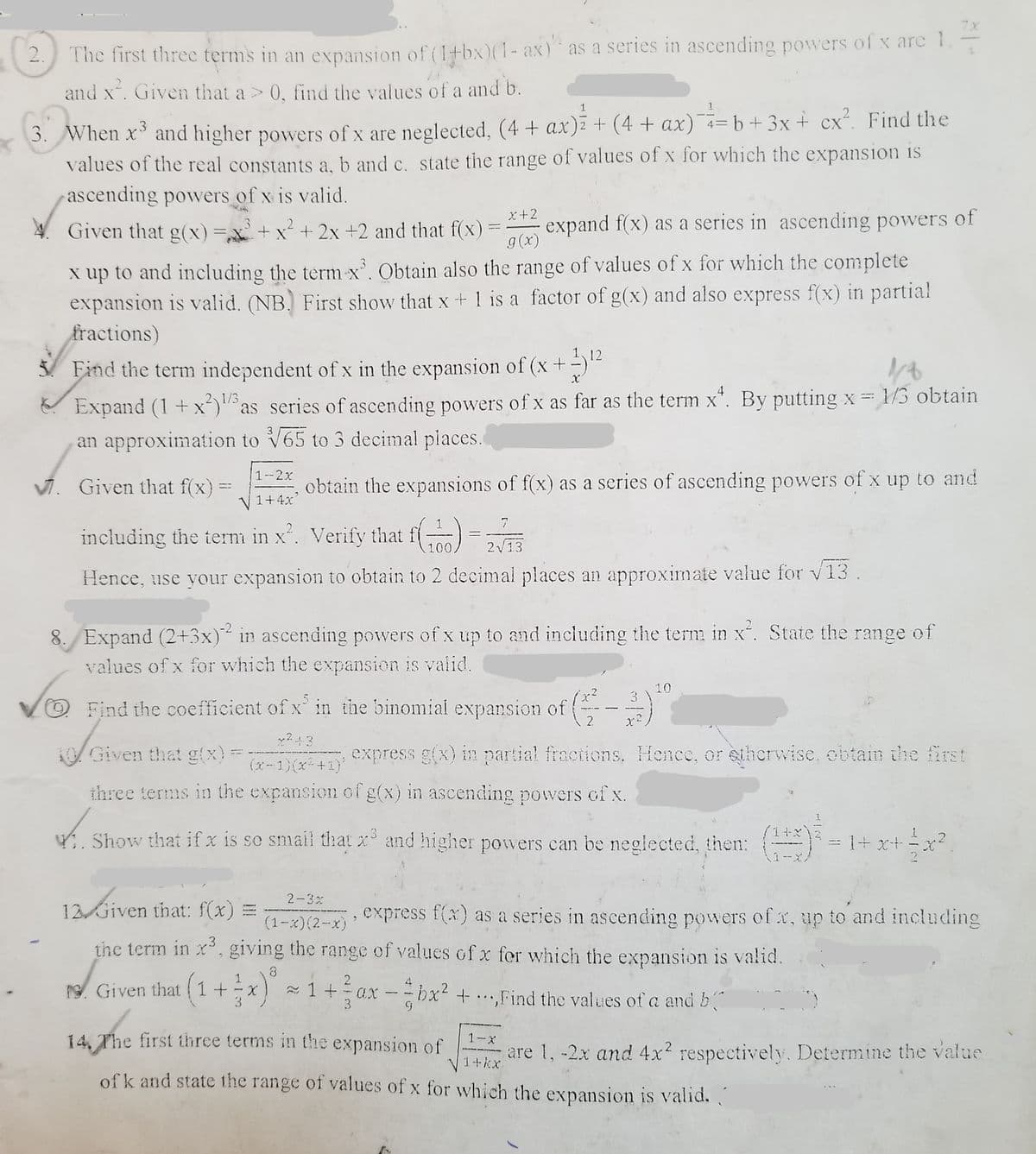Algebra & Trigonometry with Analytic Geometry
13th Edition
ISBN:9781133382119
Author:Swokowski
Publisher:Swokowski
Chapter10: Sequences, Series, And Probability
Section10.2: Arithmetic Sequences
Problem 68E
Related questions
Concept explainers
Equations and Inequations
Equations and inequalities describe the relationship between two mathematical expressions.
Linear Functions
A linear function can just be a constant, or it can be the constant multiplied with the variable like x or y. If the variables are of the form, x2, x1/2 or y2 it is not linear. The exponent over the variables should always be 1.
Question
Solve all Q13, 14 explaining detailly each step

Transcribed Image Text:7x
2.
The first three terms in an expansion of (l+bx)(1- ax) as a series in ascending powers of x are 1
and x. Given that a > 0, find the values of a and b.
3. When x and higher powers of x are neglected, (4 + ax) + (4 + ax) = b + 3x+ cx². Find the
values of the real constants a, b and c. state the range of values of x for which the expansion is
ascending powers of x is valid.
CX
x+2
Given that g(x)=,x+ x* + 2x +2 and that f(x)
g(x)
expand f(x) as a series in ascending powers of
%3D
x up to and including the term x. Obtain also the range of values of x for which the complete
expansion is valid. (NB. First show that x + 1 is a factor of g(x) and also express f(x) in partial
fractions)
12
3/ Find the term independent of x in the expansion of (x +-)
Expand (1 +x)as series of ascending powers of x as far as the term x". By putting x 1/3 obtain
an approximation to V65 to 3 decimal places.
2 1/3
1--2x
V. Given that f(x) =
obtain the expansions of f(x) as a series of ascending powers of x up to and
V 1+4x
7
including the term in x'. Verify that f) =
2V13
Hence, use your expansion to obtain to 2 decimal places an approximate value for v13.
8. Expand (2+3x) in ascending powers of x up to and including the term in x. State the range of
values of x for which the expansion is valid.
10
3
O Find the coefficient of x in the binomial expansion of
AGiven that gtx)=
express g(x) in partial fractions. Hence, or eherwise, obtain the first
(x-1)(x+1)'
three terms in the expansion of g(x) in ascending powers of x.
4. Show that if x is so smail that x and higher powers can be neglected, then:
= 1+x+xr?
2-3x
12 Given that: f(x)
express f(x) as a series in ascending powers of x, up to and including
(1-x)(2-x)
the term in x, giving the range of values of x for which the expansion is valid.
ro. Given that (1+x 1
ax
3.
-bx² +.Find the values of a and b
3.
14, The first three terms in the expansion of
who
1-x
are 1, -2x and 4x? respectively. Determine the value
1+kx
of k and state the range of values of x for which the expansion is valid.
Expert Solution
This question has been solved!
Explore an expertly crafted, step-by-step solution for a thorough understanding of key concepts.
Step by step
Solved in 3 steps with 3 images

Knowledge Booster
Learn more about
Need a deep-dive on the concept behind this application? Look no further. Learn more about this topic, algebra and related others by exploring similar questions and additional content below.Recommended textbooks for you

Algebra & Trigonometry with Analytic Geometry
Algebra
ISBN:
9781133382119
Author:
Swokowski
Publisher:
Cengage


Algebra & Trigonometry with Analytic Geometry
Algebra
ISBN:
9781133382119
Author:
Swokowski
Publisher:
Cengage
